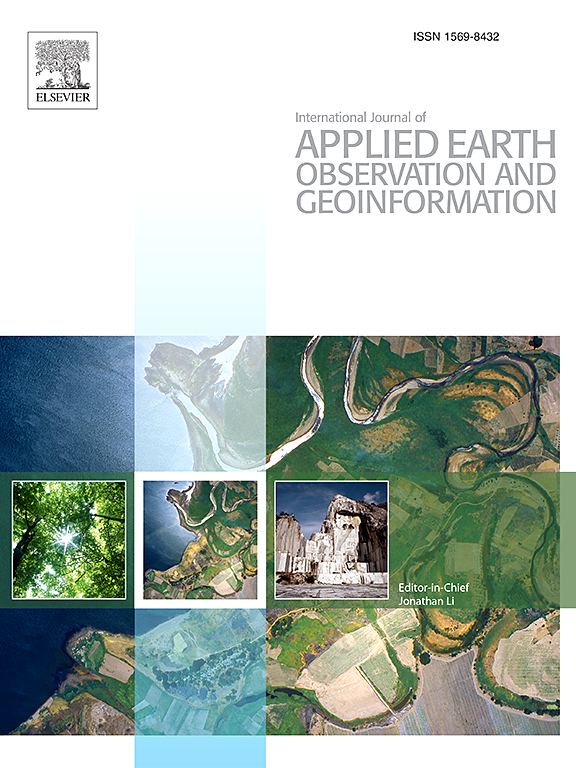HI4HC和AAAAD:基于混合智能的遥感场景字幕分层方法和数据集探索
IF 7.6
Q1 REMOTE SENSING
International journal of applied earth observation and geoinformation : ITC journal
Pub Date : 2025-03-25
DOI:10.1016/j.jag.2025.104491
引用次数: 0
摘要
遥感场景字幕是对地观测数据深入理解和智能分析的关键。许多现有的方法和数据集缺乏对关键地理要素的细粒度描述,无法捕捉空间关系的全部多样性,并且在对真实地理空间场景的适用性方面受到限制。为了解决这些缺点,我们提出了HI4HC (hybrid intelligence for remote sensing scene hierarchical captioning),这是一种结合深度学习算法和专家知识生成遥感场景分层字幕的新方法。这种方法从地理要素、空间关系和场景概念三个维度全面描述场景,从而产生更准确、详细和全面的说明。利用HI4HC,我们构建并公开了一个高质量的分层标题数据集AAAAD (adopt-amend-annihilate-add dataset)。大量的实验表明,AAAAD在地理元素的丰富度、空间关系的精度和整体标题多样性方面都优于传统的单级标题数据集,13个评估指标中的11个都有改进。此外,HI4HC生成的分层标题为用户提供了根据特定应用需求组织信息的灵活性,如图像分类、变化检测、多模态理解和跨模态检索。这种自适应性不仅缓解了遥感图像理解中的语义差距,而且对推进遥感图像的智能分析具有重要作用。AAAAD可以通过https://github.com/jaycecd/HI4HC访问。本文章由计算机程序翻译,如有差异,请以英文原文为准。

HI4HC and AAAAD: Exploring a hierarchical method and dataset using hybrid intelligence for remote sensing scene captioning
Remote sensing scene captioning is crucial for the deep understanding and intelligent analysis of Earth observation data. Many existing methods and datasets lack a fine-grained description of key geographical elements, fail to capture the full diversity of spatial relations, and are limited in their applicability to real-world geospatial scenarios. To address these shortcomings, we propose HI4HC (hybrid intelligence for remote sensing scene hierarchical captioning), a novel method that combines deep learning algorithms with expert knowledge to generate hierarchical captions for remote sensing scenes. This approach comprehensively describes scenes across three dimensions: geographical elements, spatial relations, and scene concepts, resulting in more accurate, detailed, and comprehensive captions. Leveraging HI4HC, we have constructed and made public a high-quality hierarchical caption dataset named AAAAD (adopt-amend-annihilate-add dataset). Extensive experiments show that AAAAD outperforms traditional single-level caption datasets in terms of the richness of geographical elements, the precision of spatial relations, and overall caption diversity, with improvements observed across 11 out of 13 evaluation metrics. Moreover, the hierarchical captions generated by HI4HC offer users the flexibility to organize information according to specific application needs such as imagery classification, change detection, multimodal understanding and cross-modal retrieval. This adaptability not only alleviates the semantic gap in imagery understanding but also plays an important role in advancing intelligent analysis of remote sensing imagery. AAAAD can be accessed through https://github.com/jaycecd/HI4HC.
求助全文
通过发布文献求助,成功后即可免费获取论文全文。
去求助
来源期刊

International journal of applied earth observation and geoinformation : ITC journal
Global and Planetary Change, Management, Monitoring, Policy and Law, Earth-Surface Processes, Computers in Earth Sciences
CiteScore
12.00
自引率
0.00%
发文量
0
审稿时长
77 days
期刊介绍:
The International Journal of Applied Earth Observation and Geoinformation publishes original papers that utilize earth observation data for natural resource and environmental inventory and management. These data primarily originate from remote sensing platforms, including satellites and aircraft, supplemented by surface and subsurface measurements. Addressing natural resources such as forests, agricultural land, soils, and water, as well as environmental concerns like biodiversity, land degradation, and hazards, the journal explores conceptual and data-driven approaches. It covers geoinformation themes like capturing, databasing, visualization, interpretation, data quality, and spatial uncertainty.
 求助内容:
求助内容: 应助结果提醒方式:
应助结果提醒方式:


